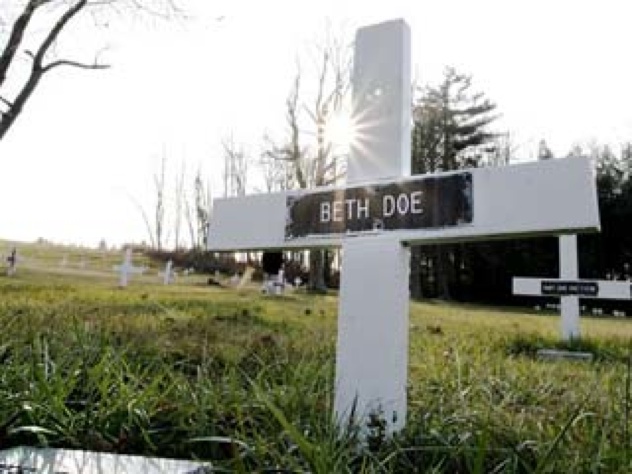 Our World
Our World  Our World
Our World  Weird Stuff
Weird Stuff 10 Fascinating Facts You Might Not Know About Snow
 Miscellaneous
Miscellaneous Top 10 Things Crypto Was Supposed to Change & What Actually Did
 History
History 10 Huge Historical Events That Happened on Christmas Eve
 Music
Music 10 Surprising Origin Stories of Your Favorite Holiday Songs
 History
History 10 Less Than Jolly Events That Occurred on December 25
 Weird Stuff
Weird Stuff 10 Funny Ways That Researchers Overthink Christmas
 Politics
Politics 10 Political Scandals That Sent Crowds Into the Streets
 Weird Stuff
Weird Stuff Ten Bizarre Facts About The Doge Meme
 Our World
Our World 10 Ways Your Christmas Tree Is More Lit Than You Think
 Our World
Our World 10 Archaeological Discoveries of 2025 That Refined History
 Weird Stuff
Weird Stuff 10 Fascinating Facts You Might Not Know About Snow
 Miscellaneous
Miscellaneous Top 10 Things Crypto Was Supposed to Change & What Actually Did
Who's Behind Listverse?

Jamie Frater
Head Editor
Jamie founded Listverse due to an insatiable desire to share fascinating, obscure, and bizarre facts. He has been a guest speaker on numerous national radio and television stations and is a five time published author.
More About Us History
History 10 Huge Historical Events That Happened on Christmas Eve
 Music
Music 10 Surprising Origin Stories of Your Favorite Holiday Songs
 History
History 10 Less Than Jolly Events That Occurred on December 25
 Weird Stuff
Weird Stuff 10 Funny Ways That Researchers Overthink Christmas
 Politics
Politics 10 Political Scandals That Sent Crowds Into the Streets
 Weird Stuff
Weird Stuff Ten Bizarre Facts About The Doge Meme
 Our World
Our World 10 Ways Your Christmas Tree Is More Lit Than You Think
10 Mysterious Cases Involving Unidentified People
Every year, there are numerous men and women found deceased whose identities are a complete mystery. They are simply known as “John Doe” or “Jane Doe” until their real identities can be discovered. But unfortunately, sometimes this just never happens. Even though these people may have friends or family somewhere who are looking them, no one ever comes forward to claim the body. Years or decades go by without anyone finding out who they are. One of the most famous examples of this is the unidentified “Boy in the Box” found in Philadelphia in 1957. Here are some other examples of John or Jane Does being found under mysterious circumstances. Even though people have worked tirelessly to find out who they are, their identities remain unknown.

On February 19, 1971, in Sumter County, Florida, the decomposed body of a young woman was discovered beneath a bridge in Lake Panasoffkee. She was believed to be in her early twenties and had been strangled to death with a man’s belt which was still wrapped around her throat. She had no identification and since no one ever came forward to claim her body, she was nicknamed “Little Miss Panasoffkee” and laid to rest in the area.
Years later, her body was exhumed in an attempt to identify her. One of the most curious discoveries they made was that a form of surgery called the “Watson-Jones” technique had been performed on her ankle. She had extensive dental work and a recent study of the lead isotopes in her teeth has led to the theory that she may have been a resident of Lavrion, a fishing port near Athens, Greece. It is also believed that she had given birth to a child at one point. In spite of these very distinct clues, her real identity has yet to be uncovered.

Another Sumter County, this one in South Carolina, has its own mystery about unidentified murder victims. On August 9, 1976, the bodies of a young man and woman, both believed to between 18 and 22 years old, were found on a secluded dirty road. They had both been shot to death, and a local resident claimed they heard the sounds of gunshots and a vehicle speeding off shortly before the victims were found. Neither the male nor the female had any identification or money on them.
Even though they had no money, the victims both wore fairly expensive-looking jewelry and had extensive dental work. Months later, a witness came forward who believed he had crossed paths with the couple at a campground. He said the male claimed his name was “Jock” and that he was traveling through the U.S. because he had been disowned by his father, who was a prominent doctor in Canada. Not much is known about the female, but authorities have speculated that the couple may have actually been brother and sister. In spite of these leads, no one has ever come forward to claim the victims’ bodies, and the identity of their killer is also unknown.

One of the most brutal homicides of all time took place in Carbon County, Pennsylvania on December 20, 1976. Three suitcases were found under a bridge along the Lehigh River and they each contained the remains of an unidentified woman, who was believed to be between 16 and 22 years old. She had been strangled, shot in the neck, and dismembered. One of the suitcases contained her arms and legs, and her eyes, nose and breasts had also been removed. It’s estimated that the killer made a failed attempt to toss the suitcases into the river, causing two of them to break open on impact.
As if the crime wasn’t vicious enough, the woman was also pregnant, as a full-term female fetus was also found amongst the remains. A potentially significant clue was some letters and numbers written in ink on the victim’s left hand (possibly a license plate number), but authorities were never able to figure out their meaning. Over thirty-five years later, the victim is buried in a grave under the name “Beth Doe”, but no one has ever been able to determine her identity or find out who killed her in such a cruel fashion.

On September 14, 2001, a man appearing to be in his twenties checked into a motel in Grays Harbor, Washington. He registered under the name “Lyle Stevik” and listed an address from Meridan, Idaho. He only paid for one evening, but told the staff he was likely planning to stay a few extra days. On September 17, his body was found in his room, hanging from a coat rack with a leather belt. It is estimated that he had committed suicide the day before. He left money on the nightstand alongside a note that said “For the Room”.
Upon further investigation, it was discovered that “Lyle Stevik” is the name of a character from the Joyce Carol Oates novel, “You Must Remember This”, so there’s a good chance this man had registered under an alias. The Idaho address he wrote down actually belonged to a Best Western motel. The man carried no identification or luggage and the only possessions left behind were a toothbrush and toothpaste. The only other clue was a discarded piece of paper in the room’s waste basket which read “SUICIDE”. All attempts to uncover anything about this man’s background have proved unsuccessful.

On the morning of November 9, 1979, a passing motorist discovered the body of a young woman in a cornfield near Caledonia, New York. She looked to be between 13 and 19 years old and was killed by two gunshot wounds to the head. Authorities estimate that the murder weapon was a .38-caliber handgun. She was likely killed the night before, but unfortunately, heavy rains had washed away potential forensic evidence. Her pockets had been turned inside out, indicating that the killer had possibly removed her identification.
A waitress reported seeing the woman at a diner in Lima, New York the night before, and numerous truckers claimed they had seen her hitchhiking and attempting to catch rides. In 2006, three microscopic pollen grains found inside her clothing were analyzed and it was determined they could have only come from Florida, Arizona or Southern California, indicating that the girl had travelled a great distance before her death. But even though authorities have followed up on over 10,000 leads, she has yet to be identified and remains buried under the name “Jane Doe” in Dansville, New York.

In Brazoria County, Texas on September 10, 1990, a motorist who pulled off the highway to relieve himself in a trash-dumping area was shocked to discover a skull inside an old tire. The skeletal remains of a female, believed to be between the ages of 15 and 25, were then found on a pile of debris. Cause of death is unknown, but it is estimated she died one to five years before being discovered. She was initially thought to be Hispanic, but later analysis has determined that she was probably white and descended from at least one black parent or grandparent.
Even though no clothing was found, the victim had six rings on her fingers and a bracelet. The most distinctive piece of jewelry was a silver-colored 1975 class ring from Robert E. Lee High School in Houston. The blue stone in the ring is what led to her being nicknamed “Princess Blue”. Given that the victim was too young to have graduated high school in 1975, investigators were baffled about why she would have this ring and have tried to find out if anyone from that graduating class might have lost or given their ring away. Thus far, they have had no luck solving this mystery.

On June 26, 1995, a man named Michael Eric Hager was killed when his van crashed in Greensville County, Virginia. A passenger was also killed in the accident, but Hager’s family did not know him, so he had presumably been picked up while hitchhiking. The unidentified man was between 16 and 21 years old and wore a tie-died concert T-shirt advertising the Grateful Dead’s 30th Anniversary Tour. He had no identification, but he did have a ticket stub from the Grateful Dead concert at RFK Stadium the night before. The ticket was traced to a Pennsylvania man who had scalped it at the concert, but could not recall who he sold it to.
One significant clue was a note found in the man’s pocket which read: “To Jason, Sorry we had to go. See you around. Caroline O. and Caroline T.”. The note also contained a phone number with a 914 prefix, but no area code. Neither of these Carolines have ever been identified and the phone number has not helped uncover the hitchhiker’s identity. This note led to the man being nicknamed “Jason Doe”, but since no one has ever come forward to claim his body, his real name remains a mystery.

One of the largest homicide investigations in New York City history was launched on July 23, 1991 when a cooler was found in a park bordering the Henry Hudson Parkway. It contained the decomposed body of a young girl, estimated to be between the ages of 3 and 5. She was wrapped in a black garbage bag and buried under cans of Coca-Cola. The girl had been asphyxiated and likely been dead for days, and evidence was later discovered that the girl was sexually abused. With no clue to her identity, she was nicknamed “Baby Hope”.
Authorities sent out a public plea for information and later received a call from a woman using the name “Judy Brown”. She claimed that while driving on the Parkway nine days before Baby Hope was found, she saw a well-dressed Hispanic couple carrying a cooler, but this woman never came forward to provide further information. While Baby Hope remains unidentified over 20 years later, detectives initially thought they solved the case when they found pornographic Polaroids of a girl resembling Baby Hope in the same area three months later. They later discovered the person in the photos was actually a 12-year old girl living in New Jersey. In an eerie coincidence, her name was also Hope!

On April 1, 1990, a young woman stepped onto Pacific Coast Highway in Huntington Beach, California, and was instantly killed after being struck by two vehicles. She carried no identification, but wore one very unique item: a ring made of human hair. When the media published a sketch of the woman, many residents came forward to claim they had interacted with her. She had told some people that her name was Andrea and that she was 25 or 26, though she looked young enough to be between 16 and 18 years old.
One resident claimed that “Andrea” was a homeless transient and that he let her spend the night with his family. This is where he witnessed the woman cut off a chunk of her hair and wrap it around her finger as a ring. Other residents who spoke with her gave conflicting stories about her being from Virginia and New York. One person said the woman mentioned she was adopted and was searching for her birth family, and also claimed her parents were pretty well-known. In spite of investigators following up on numerous leads, the woman still remains unidentified over 20 years later.

On July 9, 1991, a blonde woman was found beaten and shot to death in her room at the Whitehall Motel in El Dorado, Arkansas. Her ID said her name was Cheryl Ann Wick, but investigators soon discovered she had stolen this identity from another Cheryl Ann Wick in Minneapolis who was alive and well and did not know the victim. The blonde had been murdered by her boyfriend, James Roy McAlphin, who served 12 years in prison for the crime, but could not shed any light on her real identity.
The woman was known to have resided in Dallas, Houston, Shreveport, and Little Rock before she arrived in El Dorado, and also told friends she was originally from Florida. In addition to “Cheryl Ann Wick”, she also went under the aliases “Kelly Lee Carr”, “Shannon Wiley”, and “Mercedes”. She had worked as a prostitute and topless dancer, had been arrested on numerous occasions for prostitution and writing bad cheques, and was possibly wanted for bank robbery in Virginia. She also had a bible in her possession, which included names from a family she had lived with for awhile. In spite of all these leads, no one has ever been able to uncover her true identity.
Robin Warder is a budding Canadian screenwriter who has used his encyclopedic movie knowledge to publish numerous articles at Cracked.com. I am also the co-owner of a pop culture website called The Back Row.







